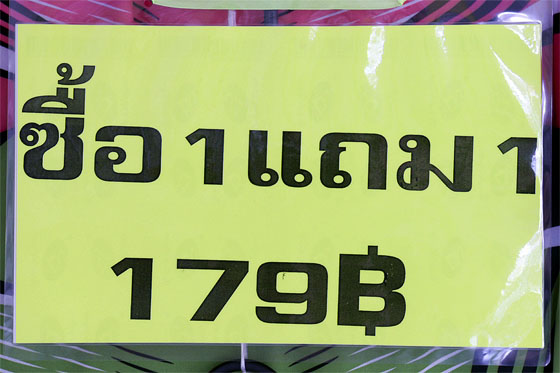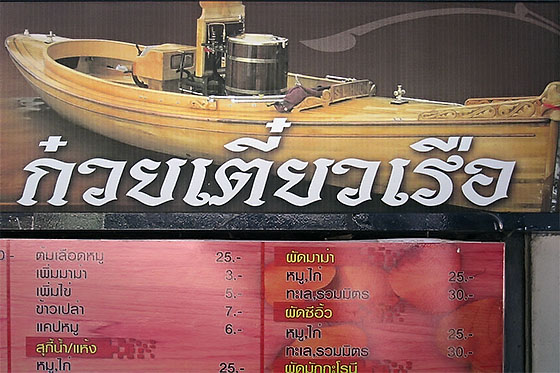Learn How To Read Thai - Tutorial 27
Strange Sounding Vowels
The ability to read some basic Thai is enormously useful when living or travelling in Thailand but it is essential if you wish to learn to speak Thai.
Learning resources that use Romanised characters to write Thai words are hopelessly inaccurate and using these books is a complete waste of time.
There is a book being sold in Thai bookshops that purports to teach foreigners how to speak Thai. On the front cover is an example of the transliteration used within the book. According to the German author, driving a car in Thailand is kab rod.
Apart from the vowel sounds being wrong the author has completely overlooked the fact that Thai consonant sounds change if they are final consonants. If a foreigner pronounces kab rod phonetically as it is written he will never be understood in Thailand.
The standard systems of transliteration are severely flawed to begin with and additionally some Thai sounds simply can't be expressed using a foreign alphabet because the Thai phonemes don't exist in other languages.
The two vowels I'm going to cover here are examples of this. As with all Thai vowels, there is a long version and a short version. Vowel length, along with the correct tone, is important in Thai.
These vowels (both long and short) are normally transliterated as 'eu' but this transliteration doesn't convey the actual sound very well. The sound is nothing like the 'Eu' in Europe and probably the best example of an English word with this sound and spelling would be 'grandeur'. If you say this word, your mouth should be quite wide when you pronounce the second syllable.
The actual sounds are more like English expressions of disgust, like the sound you would make if you stepped in a pile of fresh dog poop. But how do you write such a sound? You can't.
I refer to these vowels as the 'Wide-mouthed frog' sounds. You need to make your mouth as wide as possible to get the right sound.
With my Thai students I tell them to watch my mouth as I pronounce certain English words. The shape of the mouth and the position of the tongue is essential to make the right sounds.
Thais have to learn how to make new sounds when speaking English, and learners of Thai need to learn how to make new sounds when learning to speak Thai.
The vowels (written above the zero consonant here) are:
อึ - short
Writing practice: Download Worksheet
อื - long
Writing practice: Download Worksheet
If the word doesn't use a tone mark, use the appropriate vowel length for the tone rules (Tutorial 14).
Some Basic Words
These vowels are written above the initial consonant. If a final consonant exists it is written next to the initial consonant. If no final consonant exists, then the zero consonant character is used to complete the word.
It is impossible for me to write these sounds in English so I will just use 'eu'. However, remember that one vowel sound is longer.
Here are some examples with no final consonant:
มือ - meu ('hand'). There is no final consonant and so the zero consonant is used. The sound is just an 'm' initial consonant (Tutorial 8) followed by the long 'eu' vowel. Low class initial consonant + live syllable = mid tone.
มือถือ - meu teu. There are two words here and both have the same long 'eu' vowel sound. The first initial consonant is 'm' (Tutorial 8) and the second 't' (Tutorial 15). This is the Thai for 'mobile phone'. The second word is high class consonant + live syllable = rising tone.
คือ - keu (verb to be). The initial consonant is one of the three Thai 'k' consonants. There used to be five but two are now obsolete. See Tutorial 5. Low class initial consonant + live syllable = mid tone.
Now here are some examples with a voiced final consonant and therefore we don't need the zero consonant:
ปืน - the long 'eu' vowel comes in between the 'bp' initial consonant (Tutorial 3) and an 'n' final consonant (Tutorial 8). The Thai word bpeun means 'gun'. Mid class initial consonant + live syllable = mid tone.
ผึ้ง - the short 'eu' sound comes in between a 'p' initial consonant (Tutorial 17) and the 'ng' final consonant (Tutorial 4). The Thai word peung means 'bee'. High class initial consonant + second tone mark = falling tone.
ดึง - the short 'eu' sound comes in between a 'd' initial consonant (Tutorial 6) and the 'ng' final consonant (Tutorial 4). The Thai word deung means 'pull' (as in door). Mid class initial consonant + live syllable = mid tone.
หนึ่ง - the short 'eu' sound comes in between a 'n' initial consonant (Tutorial 8) and the 'ng' final consonant (Tutorial 4). The leading hor heep is silent and only here for tone rule purposes (Tutorial 12). The Thai word neung is the number 'one'. High class initial consonant + first tone mark = low tone.
หึง - the short 'eu' sound comes in between an 'h' initial consonant (Tutorial 9) and the 'ng' final consonant (Tutorial 4). The Thai word heung means 'to be jealous'. High class initial consonant + live syllable = rising tone.
คืน - the long 'eu' vowel comes in between a 'k' initial consonant (Tutorial 5) and an 'n' final consonant (Tutorial 8). The Thai word keun means 'night' or 'to give back' as in a loan. Low class initial consonant + live syllable = mid tone.
Words With An Extra Syllable
The examples above are words consisting of one syllable. However, where a zero consonant is used in addition to a final consonant, the word gets another syllable. These words are prefixed with the 'sara ay' vowel (Tutorial 16).
Writing practice: Download Worksheet
Writing practice: Download Worksheet
Here are some examples:
เพื่อน - peu-un (friend) - falling tone
เลือก - leu-uk (to choose) - falling tone
เมือง - meu-ung (normally 'city' but my dictionary says: world, country, land, province, town, city, urban) - mid tone
With some words you may see the 'sara ay' vowel and the zero consonant but no final consonant. These words have two syllables but just end with 'uh'. For example:
เกลือ - gleu-uh (salt) - mid tone
เนื้อ - neu-uh (meat/flesh) - high tone
เพื่อ - peu-uh (for, for the purpose of) - falling tone
เสือ - seu-uh (tiger) - rising tone
เสื่อ - seu-uh (mat) - low tone
เสื้อ - seu-uh (shirt) - falling tone
Be a little careful with this.
หรือ - reu (or) - one syllable. The leading hor heep is silent and only here for tone rule purposes (Tutorial 12). High class initial consonant + live syllable = rising tone
เรือ - reu-uh (boat) - two syllables, mid tone
ซื้อ - seu (to buy) - one syllable, high tone

seu neung tairm neung - Buy one, get one free
The vowel combination we looked at above is considered a long vowel. Here it is with the silent consonant:
เอือ - long vowel
In various lists of Thai vowels I have seen a shortened version. It is shortened by adding sara uh to the end:
เอือะ - short vowel
However, I have been unable to find any actual Thai words that use this vowel combination. According to my Thai wife, there aren't any.
There are some examples of the longer 'eu' vowel in this sign:

seu kaay torasup meu teu - Mobile phones bought and sold

gwy dtiaew reu-uh - 'Boat noodles' is a Thai dish

deung - If you see this sign on a door you need to pull - pluk means to push
And regarding the photo at the top of the page, this is what every Thai girl will tell you.
คิดถึง - kit-teung (to think of/to miss/to long for someone or something)
Inconsistencies
 Now that you have remembered all of this and are keen to go to Thailand to test your reading ability, what happens when you arrive at the old international airport in Bangkok and see the name of the airport transliterated as Don Muang or Don Mueang? The word meu-ung can be found above.
Now that you have remembered all of this and are keen to go to Thailand to test your reading ability, what happens when you arrive at the old international airport in Bangkok and see the name of the airport transliterated as Don Muang or Don Mueang? The word meu-ung can be found above.
ดอนเมือง
You've studied all of Phil's tutorials and you know that both of these English transliterations are wrong.
All I can say is that the only consistency with Thai to English transliteration is the fact that it is never consistent. Ignore it. As an enlightened traveller who can now read Thai, you have no need for this stupid system. It's just there for the unknowing and unseeing tourists.
Funny Translations
The following translation made me laugh, but if you know some Thai you can work out why this kind of thing happens.

Funny translation
Often in Thai there are multiple words for a noun or verb when there is only one word in English. Conversely, some single Thai words are used for many purposes, whereas in English there would be several different words. For example, in English there are different words for deny, refuse, reject, negate, decline, whereas in Thai there is only one.
ปฏิเสธ - bpuh-dti-set (used for all the above)
The Thai word 'rup' is another single word that is used for many things, whereas in English several different words would be used.
รับ - rup (to receive, take, get, obtain, undertake; to bear, suffer; to accept, agree, adopt; to admit; to answer; to meet)
It is the same with the Thai word 'kreu-ung'. If you look in a Thai dictionary there are many words that begin with 'kreu-ung'.
เครื่อง - kreu-ung
It can mean 'machine or engine' and 'kreu-ung yon' is a vehicle engine. However, when you go to a restaurant you will be asked about 'kreu-ung deum' because 'kreu-ung' can also mean 'things'. 'Deum' is 'to drink' and thus 'kreu-ung deum' means beverages in Thai.
เครื่องดื่ม - kreu-ung deum (beverages, drinks)
The word 'nai' means 'in, inner, internal' and thus 'kreu-ung nai' is the Thai word for internal things, actually organs, of the body or offal. Asians are very keen on eating parts of the animal that most Westerners throw away. The British eat some offal and my mother used to prepare braised lamb hearts, but it is very unusual for Americans.
On one occasion I was hosting an American colleague at work in the UK and we went to the staff cafeteria. On the menu was steak and kidney pie, a British favourite. He asked if the 'kidney' meant kidney beans. When he realised that it was real kidney he started to look physically ill.
Thais use the same word for pork and pig - 'moo'. What is being sold by this food vendor is pig offal. Obviously, when the vendor wanted to add an English sign, he or she went to the dictionary and used the first translation and didn't look at - or understand - all the other possibilities.
เครื่องในหมู - kreu-ung nai moo
'Pig machine in' is stewed pig offal - a favourite with Thais, and especially Chinese.
Questions And Feedback
If you have any comments, questions or suggestions, feel free to contact me. Your feedback will help me to improve these pages.
Recommended Books
Amazon UK
Amazon UK
Amazon US
Amazon US

